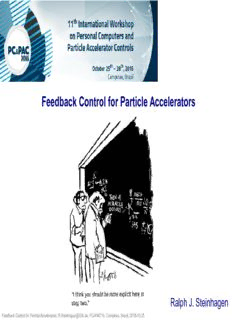Table Of ContentFeedback Control for Particle Accelerators
Ralph J. Steinhagen
Feedback Control for Particle Accelerators, R.Steinhagen@GSI.de, PCaPAC'16, Campinas, Brazil, 2016-10-25
Overview
Part I – Introduction
– Real-World examples, similarities across domains and its synergies
– Classic 'control theory' recap: s-parameter, time- & frequency-domain definitions, terminology, etc.
• Stability, Controllability, Observability
– a practical but not-so-optimal PID tuning strategy
Part II – Optimal Linear Multivariate- & MIMO-Controller Design
– Space & Time Domain concepts
– Trade-off between disturbance rejection & noise attenuation
– Examples
Part III – Optimal Non-Linear Controller Design
– focus on latency/lag- & rate-limiter compensation (communication, digitization, GBW-limits, power-limits, etc.)
– Inter-loop dependencies: cross-dependability and cross-constraints between feedback loops
– Robustness and modelling errors
– best practices: control room-level integration, system validation, improvement of model/feed-forward
Part IV – Discussion, Open-Round and more detailed Q&A
Primary goal: provide a roadmap to avoid less obvious FB 'pot holes'
N.B. please feel free to interrupt me
Feedback Control for Particle Accelerators, R.Steinhagen@GSI.de, PCaPAC'16, Campinas, Brazil, 2016-10-25 in case you have pressing questions
Literature
M. Salgado G. Goodwin, S. Graebe,
“Control System Design”, Prentice Hall, 2000
G. F. Franklin, J. D. Powell, Abbas Emami-Naeini,
“Feedback Control of Dynamic Systems”, 7th Edition,
Pearson, 2014
Gene F. Franklin, J. David Powell, Michael Workman,
“Digital Control of Dynamic Systems”, 3rd edition,
Addison Wesley, 1997
Paul Horowitz & Windfield Hill,
“The Art of Electronics”, Cambridge Uni.-Press
IEEE Transactions and Journals, notably:
– Instrumentation and Measurement
– Microwave Theory and Techniques
– Control Theory & Applications
… and of course: https://www.microwaves101.com/
Feedback Control for Particle Accelerators, R.Steinhagen@GSI.de, PCaPAC'16, Campinas, Brazil, 2016-10-25
Control Paradigms I/II
Parameter control, either through...
Feed-Forward: (FF)
– Steer parameter using precise process model and disturbance prediction
Feedback: (FB)
– Steering using rough process model and measurement of parameter
– Two types: within-cycle (repetition Δt<<10 hours) or cycle-to-cycle (Δt>10 hours)
predicted disturbance
+
+ Feed-Forward:
Σ Model
M → E
actual disturbance
Reference
+ + + Parameter: e.g.
Σ ΔP' Feedback: + Process: +
Σ Σ Energy, Orbit,
ΔP' → E E → P
Q, Q', c-, RF etc.
-
P' measurement noise
+
Monitor: + P
Σ
P → P'
Feedback Control for Particle Accelerators, R.Steinhagen@GSI.de, PCaPAC'16, Campinas, Brazil, 2016-10-25
Control Paradigms II/II
Machine imperfections cause steady-state offset ε and scale error ε :
ss scale
x s= R s⋅ x s=R s⋅ 1 ⋅
i i i ss scale i
Feed-Forward: Integral feedback:
Reference = 1 Reference = 1
r r actual parameter
e e
t 1-ε t 1-ε
e e
m m
a actual parameter a
r r
a a
p p error signal Δ =
. . integral feedback signal
m m
r r
o o
n n
time 1rst 2nd ... nth time
Uncertainties and scale error of beam response function affects convergence speed
(= feedback bandwidth) rather than achievable stability
Feedback Control for Particle Accelerators, R.Steinhagen@GSI.de, PCaPAC'16, Campinas, Brazil, 2016-10-25
Beam Parameter Stability in Particle Accelerators
… notably in Hadron Machines
LHC:
Traditional requirements on beam stability...
50.0 mm
Beam screen
... to keep the beam in the pipe!
36 mm
LHC's increased stored intensity and energy →
much tighter requirements on beam stability:
1. Capability to control particle losses
• Machine protection (MP) & Collimation
• Quench prevention
2. Commissioning and operational efficiency
Beam 3 envel.
~ 1.8 mm @ 7 TeV
FBs became a requirement for safe and reliable nominal LHC operation
– implications on controller reliability, availability and system integration
Feedback Control for Particle Accelerators, R.Steinhagen@GSI.de, PCaPAC'16, Campinas, Brazil, 2016-10-25
Beam Parameter Stability in Particle Accelerators
LHC Requirements on Orbit – Machine Protection
Combined failure1: Local orbit bump and collimation efficiency (/kicker failure)
→ local orbit bumps may potentially compromise collimation function
e.g 'bump in arc'
IR2 IR3
Potentially:
N [σ]
< 6.7
a
~7.5σ
secondary halo
6.7
5.7
closed orbit
MKI TDI TCP & TCS
Collimation inefficiency vs. orbit error1
Coll. system
version ~ 2002
need to operate here!
↔ Δx < 100 μm
Iberian pkpk
peninsula
courtesy R. Assmann
Tight settings (2012):
~2.2 mm gap at primary collimator peak-to-peak orbit error [σ]
Feedback Control for Particle Accelerators, R.Steinhagen@GSI.de, PCaPAC'16, Campinas, Brazil, 2016-10-25
LHC Feedback Operation – Example
Orbit feedback used routinely and mandatory for nominal beam
Typical stability: 80 (20) μm rms. globally (arcs)
Most perturbations due to Orbit-FB reference changes around experiments
Feedback Control for Particle Accelerators, R.Steinhagen@GSI.de, PCaPAC'16, Campinas, Brazil, 2016-10-25
Beam Parameter Stability in Lepton Machines
(e+e- Collider, Light Sources, ...)
Main requirements for orbit stability8: y
– Effective emittance preservation
τ
τ
( d sampling/integration time, flucftuation time)
cm
τ ≫ τ : ϵ =ϵ +ϵ
d f eff 0 cm
o
τ ≪ τ : ϵ ≈ϵ +2 ϵ ϵ +ϵ
√
d f eff 0 0 cm cm
y
• Minimisation of coupling
(vertical orbit in sextupoles) eff
• Minimisation of spurious dispersion vertical
(vertical orbit in quadrupoles)
aperture
– Collider Luminosity and collision point stability
L.Farvacque, ESRF
√
{(¯x−x)² (¯y−y)² } ( θ σ )2
L=L ⋅exp + ⋅1/ 1+ c z ⋅ …
0 2 σ2 2 σ2 2σ
x/ y
x y
→ Nearly all 3rd generation light-sources deploy at least orbit/energy feedbacks1-3
Feedback Control for Particle Accelerators, R.Steinhagen@GSI.de, PCaPAC'16, Campinas, Brazil, 2016-10-25
Beam Parameter Stability in Lepton Machines
(e+e- Collider, Light Sources, …) here: Swiss-Light-Source, PSI
Orbit-FB @ Swiss-Light-Source, PSI (SLS)
– um-resolution orbit stability achieved during routine operation
Organised IWBS’04: http://iwbs2004.web.psi.ch/
– very good and well organised workshop!
– validated, basis and jump-started Orbit-FB designs of many
other synchrotron light sources & LHC to follow
courtesy T. Schilcher, M. Böge, B. Keil et al., PSI
Feedback Control for Particle Accelerators, R.Steinhagen@GSI.de, PCaPAC'16, Campinas, Brazil, 2016-10-25
Description:Part II – Optimal Linear Multivariate- & MIMO-Controller Design. – Space & Time Domain concepts Theory & Applications … and of course: https://www.microwaves101.com/ . one-turn-feedbacks/phase-loop: longitudinal shunt impedance, beam loading compensation. (limited RF power & power

